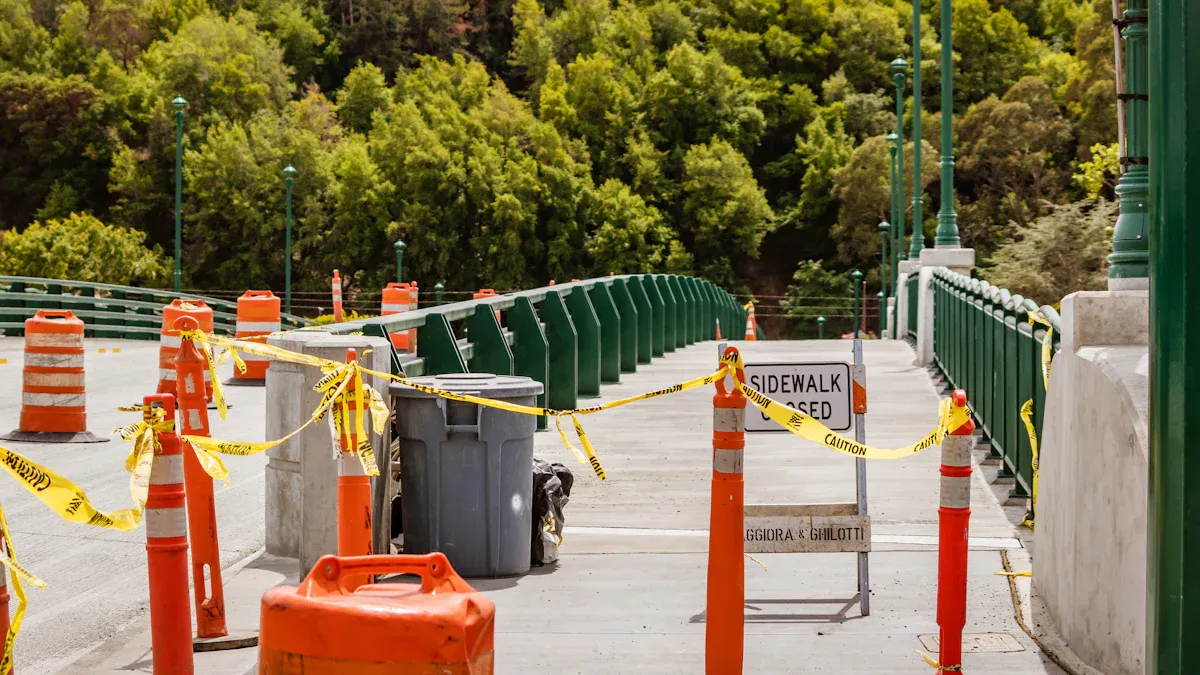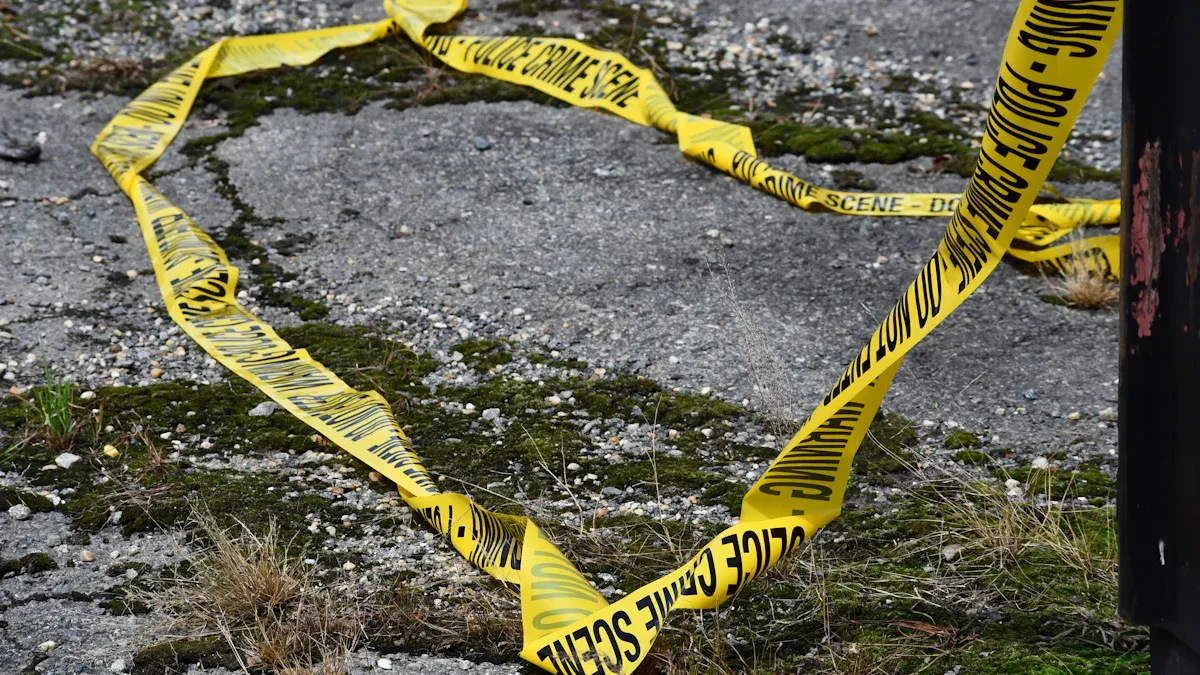How Warning Tape Saves Lives on the Road

Image Source: pexels
Have you ever thought about how tape can save lives? Warning tape, like shiny orange stickers, helps make roads safer. These stickers help vehicles stand out, even in the dark. For example, studies show reflective tape on big trailers cuts night crashes by 21%. It also stops up to 7,800 accidents every year. That’s a big change! By making vehicles easier to see, these stickers help drivers notice them sooner. This gives drivers more time to react and avoid crashes.
Key Takeaways
-
Warning tape helps cars stand out, especially in dim light or rain, lowering accident chances.
-
Bright orange reflective stickers are cheap and simple to use, making roads safer.
-
Putting warning tape in the right spots is important; it should be seen from the back and sides to warn other drivers.
-
Taking care of warning tape keeps it working well; look for damage and clean it to keep it bright.
-
Using warning tape with other safety items, like LED lights, makes cars easier to see and cuts down on accidents.
Understanding Warning Tape and Orange Stickers
What Is Warning Tape?
Warning tape is a simple way to make roads safer. It’s a shiny material that helps vehicles stand out, especially in dim light or bad weather. You might have seen it on trucks, trailers, or construction vehicles. Its bright colors and shiny surface catch the eye, making it easier for drivers to notice these vehicles from far away. This extra visibility helps stop accidents from happening.
Scientists tested how well warning tape reflects light using a special tool. They checked how much light bounces back at angles like 0 and 30 degrees. The tests showed that higher light readings mean better visibility, which is key for road safety.
Features of Reflective Orange Stickers
Reflective orange stickers are a type of warning tape with special features. First, they shine brightly when headlights hit them, making them great for dark or foggy conditions. Second, they are tough and can handle rain, snow, or heat without losing their shine. Third, they are easy to stick on and stay put for a long time.
These stickers aren’t just for looks—they save lives. Their brightness makes vehicles with dangerous loads or big sizes easy to spot. This gives other drivers enough time to react and stay safe.
Common Uses in Vehicle Safety
Warning tape is used in many ways to keep vehicles safe. For example, it’s often placed on the back and sides of big trailers. This helps other drivers see them clearly, even in bad lighting. Studies show that reflective tape makes these vehicles more visible and lowers crash risks.
It’s also required by law for vehicles carrying dangerous materials to use warning tape. This ensures they are easy to see, reducing the chance of accidents. Whether it’s a construction truck or a chemical transport vehicle, warning tape helps keep everyone safe.
How Warning Tape Improves Road Safety
Seeing Clearly in Dark or Bad Weather
Have you ever driven at night or in bad weather? It can be hard to see other cars. Warning tape helps by reflecting light from headlights. This makes vehicles easier to see, even in the dark. In fog, rain, or snow, bright orange tape stands out. It helps drivers spot vehicles from far away. This extra visibility gives time to react and avoid crashes.
Think about construction zones or dark highways. These places can be risky without good visibility. Adding warning tape to vehicles helps a lot. It’s like giving your car a glowing shield for safety.
Stopping Rear-End Crashes
Rear-end crashes happen often, especially in low light. Drivers sometimes don’t see cars ahead in time. Warning tape fixes this by making vehicles more visible. Reflective tape on the back of a car acts as a warning. Other drivers can see it sooner and slow down.
Big trucks and trailers use warning tape to mark their edges. This helps smaller cars stay at a safe distance. It’s a simple way to prevent rear-end accidents.
Keeping Hazardous Material Transport Safe
Trucks carrying dangerous materials need to be seen clearly. They must use warning tape to stay safe. Bright orange tape tells other drivers to be careful and keep away.
Imagine a truck with chemicals driving in snow. Without warning tape, it could cause a big accident. Reflective tape helps everyone notice the truck and stay alert. It’s not just a rule—it saves lives.
Benefits of Using Orange Stickers on Vehicles
Affordable Way to Stay Safe
You don’t need to spend a lot for safety. Orange stickers are cheap and make vehicles easier to see. They cost little but help prevent costly accidents. A small sticker can save you from big repair bills. It’s a smart and low-cost way to stay safe.
These stickers are simple to stick on yourself. No need to pay someone else to do it. Whether you drive a truck or a car, orange stickers are a great choice for safety.
Strong and Weather-Proof
Worried about bad weather ruining the stickers? Don’t be. These stickers are made to last in tough conditions. They stay shiny and strong through rain, snow, or heat. Here’s how they hold up:
| Feature | Details |
|---|---|
| Weather Resistance | Lasts 7 to 10 years |
| Durability | Long-lasting outdoors |
| Applications | Used for signs and highways |
| Feature | Details |
|---|---|
| Weather Resistance | Reflects well in bad weather |
| Durability | Lasts 3-5 years |
These stickers are tough and reliable. They keep vehicles visible in storms, icy roads, or hot days. You can trust them to work in any weather.
Follows Safety Rules
Safety isn’t just about being careful—it’s also about rules. Orange stickers meet important safety standards. For example, OSHA uses orange for warning signs to show danger. The ANSI Z535.1 standard also says orange is best for warnings.
Using these stickers helps you follow safety rules. They make roads safer for you and others. It’s a win for everyone.
Proper Application of Caution Tape on Vehicles

Image Source: pexels
Picking the Right Spot
Placing caution tape in the right spot is important. It should be where other drivers can see it easily. The back and sides of your vehicle are the best places. These spots are in a driver’s view, especially at night or in bad weather. For trucks or trailers, put the tape along the edges. This shows the shape of your vehicle, making it easier to notice and avoid.
For vehicles carrying dangerous materials, placement matters even more. Reflective orange stickers or caution tape should mark danger areas. This helps other drivers see your vehicle from far away and stay safe.
Easy Steps to Apply Caution Tape
Putting on caution tape is simple if done correctly. Follow these steps to make sure it sticks well:
-
Clean the Surface: Wash the area where the tape will go. Dirt or grease can stop it from sticking.
-
Measure and Cut: Measure how much tape you need and cut it carefully. Don’t waste any.
-
Peel and Stick: Take off the backing and press the tape firmly. Make sure there are no bubbles.
-
Secure the Edges: Press the edges down tightly so they don’t peel later.
If using caution tape in places like construction zones, stretch it tight. Secure it 4–5 feet above the ground with staples, nails, or cones.
Making the Tape Last Longer
To keep caution tape in place, focus on how it sticks. Always apply it to a smooth, dry surface. Avoid rough or wet areas, as they can make the tape come off. If it’s cold or wet, wait for the surface to dry before applying.
For better sticking, use a heat gun or hair dryer to warm the tape after applying. This helps it stick stronger. Check the tape often, especially after rain or snow. Replace it if it starts peeling or fading.
Pro Tip: Keep a roll of caution tape in your car. It’s handy for quick fixes or extra visibility when needed.
Additional Tips for Maximizing Safety with Warning Tape
Combining Warning Tape with Other Safety Tools
Warning tape works great on its own, but pairing it with other safety tools can make your vehicle even safer. Think about adding LED lights or reflective cones to your setup. These tools grab attention and make your vehicle stand out even more, especially in tricky situations like construction zones or on dark roads.
You can also use hazard signs or flashing lights to warn other drivers about your vehicle. For example, if you’re parked on the side of the road, a combination of warning tape and flashing lights can help others spot you from far away. This reduces the risk of accidents and keeps everyone safe.
Regular Maintenance and Inspection
Keeping your warning tape in good shape is just as important as applying it. Over time, dirt, grime, and weather can wear it down. Make it a habit to check the tape regularly. Look for peeling edges, fading colors, or dirt buildup. If the tape looks dull or damaged, replace it right away.
Cleaning the tape is simple. Use a damp cloth to wipe off dirt and keep it shiny. During winter weather, check the tape more often. Snow and ice can cover it, making it less effective. A quick inspection can go a long way in keeping your vehicle visible and safe.
Educating Drivers on Visibility Practices
Even the best safety tools won’t work if drivers don’t know how to use them. Take time to learn about visibility practices. For example, always turn on your headlights in low-light conditions. This helps the warning tape reflect better and makes your vehicle easier to see.
If you drive a truck or a vehicle carrying hazardous materials, share these tips with your team. The more people know about staying visible, the safer the roads will be for everyone.
Orange warning tape stickers are more than just decorations—they save lives. They help vehicles stand out, even in bad weather or at night. Adding them can stop crashes and keep people safe.
Here’s why they’re a smart choice:
-
Affordable: They’re cheap but provide great safety advantages.
-
Durable: Made to handle tough weather conditions.
-
Effective: They follow safety rules and work when needed most.
Pro Tip: Use these stickers with other safety tools for better protection. Small steps can make a big difference in keeping roads safe.
By applying and caring for these stickers correctly, you’re not just obeying rules—you’re helping make roads safer for everyone.
FAQ
Why do vehicles use warning tape?
Warning tape makes vehicles easier to see. It’s helpful in dark or bad weather. This lowers the chance of accidents. It’s especially useful for big trucks or vehicles with dangerous loads.
Can warning tape handle bad weather?
Yes, it can. Warning tape works well in snow, rain, or heat. It stays shiny and strong in tough weather. Its design keeps vehicles visible no matter the conditions.
Where should I put warning tape on my vehicle?
Put warning tape where others can see it easily. Good spots are the back and sides of your vehicle. For trucks or trailers, mark the edges to show their shape. This helps other drivers notice them quickly.
Is warning tape legally required?
Yes, sometimes. Vehicles carrying dangerous items must use warning tape. This follows safety rules and makes them easier to see. These laws help prevent accidents.
When should I replace warning tape?
Check your warning tape often for damage or dirt. Replace it if it’s peeling, faded, or not shiny anymore. Keeping it in good shape helps your vehicle stay safe and visible.
- by:www.top-tapes.com -